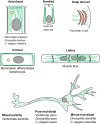Microtubule organization, dynamics and functions in differentiated cells
- PMID: 28851722
- PMCID: PMC5611961
- DOI: 10.1242/dev.153171
Microtubule organization, dynamics and functions in differentiated cells
Abstract
Over the past several decades, numerous studies have greatly expanded our knowledge about how microtubule organization and dynamics are controlled in cultured cells in vitro However, our understanding of microtubule dynamics and functions in vivo, in differentiated cells and tissues, remains under-explored. Recent advances in generating genetic tools and imaging technologies to probe microtubules in situ, coupled with an increased interest in the functions of this cytoskeletal network in differentiated cells, are resulting in a renaissance. Here, we discuss the lessons learned from such approaches, which have revealed that, although some differentiated cells utilize conserved strategies to remodel microtubules, there is considerable diversity in the underlying molecular mechanisms of microtubule reorganization. This highlights a continued need to explore how differentiated cells regulate microtubule geometry in vivo.
Keywords: Centrosome; Differentiation; Microtubule; Nucleation.
© 2017. Published by The Company of Biologists Ltd.
Conflict of interest statement
Competing interestsThe authors declare no competing or financial interests.
Figures




References
Publication types
MeSH terms
Grants and funding
LinkOut - more resources
Full Text Sources
Other Literature Sources
Miscellaneous

